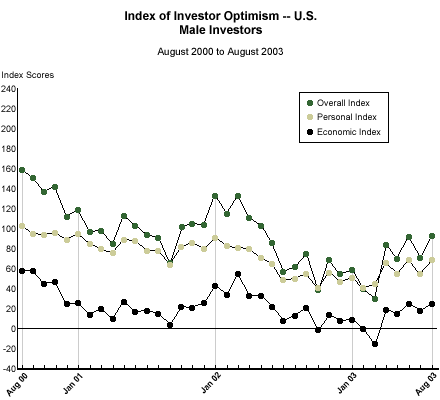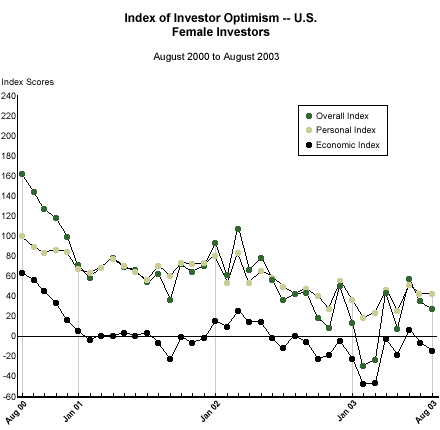The gender gap in investor optimism increased again in August, as men became more optimistic and women did just the opposite, according to the UBS/Gallup Index of Investor Optimism*. Optimism among men reached a new high for the year, while optimism among female investors extended its July decline. Overall investor optimism showed a slight increase for the month (see "Why the Divergence in Investor Optimism?" in Related Items).
In August three years ago, there was no significant gender gap in investor optimism. At that time, men and women had the same, very optimistic view of the U.S. investment climate. Since then, optimism among male investors and female investors has declined. For most of this time, however, women have been much less optimistic than men.
Economic performance data have shown that female investors, with their less enthusiastic view about the U.S. investment climate, have generally been better prognosticators than male investors have during the past several years. Looking ahead, we can't help but wonder if the gender gap in investor optimism will continue to expand, and if it does, will women continue to be better investment climate forecasters than men are?
Men Are Getting More Optimistic
The Index of Investor Optimism among men increased 22 points to 92 in August, fully offsetting its July decline. Male investor optimism is now one point above its June level (91), and at its highest point since May 2002 (102). The Personal Dimension of the Index, which reflects respondents' views of their own financial situations, increased 14 points to 68 among men this month. The Economic Dimension, which reflects investors' opinions about the overall U.S. economy, increased seven points to 24 among men.

Women Are Getting Less Optimistic
At the same time, female investors' overall optimism continued to decline in August, falling eight points to 27. This follows a 22-point drop in July and places the Index at less than half its June level (57). Among women, the Personal Dimension remained unchanged in August at 42. The Economic Dimension of the Index decreased eight points to -15, indicating that female investors have an overall pessimistic view of the economic outlook over the next six months.

Women Have Been Right in the Past
In August 2000, there was essentially no gender gap in investor optimism -- the Index stood at 159 among men and 161 among women. One year later, the gap was 30 points -- optimism had fallen to 91 among men and 61 among women. By August 2002, optimism among men had declined to 61 and that among women had fallen to 42, for a gender gap of 19 points. In August 2003, the gender gap stands at 65 points.
Over the past few years, male investors have tended to be very enthusiastic about the potential for a strong economic recovery. Women have tended to take more of a wait-and-see approach.
Will the Gender Gap Shrink?
Assuming the economy continues to expand in the months ahead, one might presume that the current gender gap in investor optimism will shrink. If female investors are waiting for real evidence of an economic recovery, then continued economic expansion and increasing corporate profits should increase their optimism more than that of their male counterparts, who have already been anticipating such a recovery.
On the other hand, perhaps female investors won't really believe a sustainable economic recovery is underway until the job market improves. If this is the case, then the investor optimism gender gap is likely to not only continue, but also expand. Unless economic growth begins to accelerate at a much faster pace than is generally expected, the job market is not likely to show a lot of improvement until early 2004.
At this point, I'm not willing to bet against the success of female investors as a group. Instead, I'll be watching closely to see what happens to the investor optimism gender gap during the next couple of months.
*Results for the Index of Investor Optimism -- U.S. are based on telephone interviews with a randomly selected U.S. sample of 803 adult investors, aged 18 and older, with at least $10,000 of investable assets, conducted Aug. 1-14, 2003. For results based on these samples, one can say with 95% confidence that the maximum error attributable to sampling and other random effects is ±4 percentage points. In addition to sampling error, question wording and practical difficulties in conducting surveys can introduce error or bias into the findings of public opinion polls.

